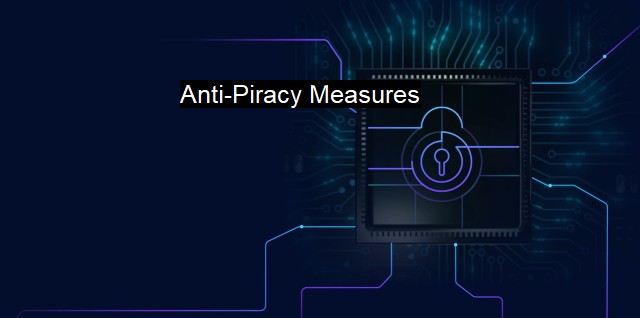What are Anti-Piracy Measures?
Up Against Piracy: Understanding Anti-Piracy Measures to Protect Intellectual Property in the Digital Media Industry
Antipiracy measures can be defined as techniques and strategies employed by software companies, governments, and other entities to mitigate and combat the unauthorized reproduction, distribution, and use of copyrighted materials or intellectual property. A significant component of these activities hovers within the realm of cybersecurity and covers a vast stream of areas including software, music, movies, video games, books, digital media, and more.The rise of digital technology and the internet has significantly made it easier for pirates to carry out their activities. According to a recent report published by the Global Internet Phenomena, piracy accounted for over 20 percent of all internet traffic in 2017. That said, digital piracy constitutes an ever-increasing threat to businesses, governments, and individuals. It leads to substantial financial losses and potentially severe security risks, especially when considering illicitly obtained and shared softwares that may contain harmful malware or be devoid of critical security updates.
Anti-piracy measures are put in place to mitigate these threats and curb the negative impacts of digital piracy. They have become vital components in today’s cybersecurity strategies, which are aimed at protecting not just copyrights but also consumers and economies at large. These measures are operating through different practices.
One dominant form of these preventative strategies is the implementation of Digital Rights Management (DRM). DRM uses technology to limit the use of copyrighted digital media after sale. This can restrict anything from the total number of devices on which a user can access a file to the number of times someone is allowed to download or share a file after purchasing.
Authentication is another common anti-piracy measure. It involves verifying software licenses and ensuring that only those users who own legal copies of the particular software use it. most software requires product keys or online activations to authenticate the legitimacy of their copies. Some companies take this a step farther, employing regular checks or ping services to ensure that the software continues to be used legally.
Code obfuscation is another anti-piracy measure within the cybersecurity landscape. This method aims to change the software’s code and make it difficult to understand, thus preventing hackers from reverse-engineering it. Encrypted algorithms are put into place, which makes it almost impossible to detect dubious manoeuvres, like tampering.
Software tampering detection is another proactive method of enforcing anti-piracy measures. This invariably entails detecting any modifications made to the software after its release. Any modifications or changes in the code are automatically detected, and depending on how the software has been lexicalized to handle continuous checks, the program can either cease operation or perform anomaly detection procedures.
Another anti-piracy strategy incorporates techniques referred to as 'watermarking’, where unique, noticeable marks embedded in digital media act as identifiers for pirated content.
The international community has developed comprehensive policies and laws to combat piracy. Copyright infringement is illegal in many jurisdictions, and individuals found guilty may face serious consequences, which can range from substantial fines to imprisonment.
Anti-piracy measures play crucial roles in preventing financial losses and protecting security. While they do impose restrictions on the use of digital media, they ultimately benefit the creators, who re-invest revenues back into creating more digital products, thereby sustaining the cycle of development, creation, and innovation. Given the wide-ranging piracy practices today, significant steps have been taken to instigate robust anti-piracy measures, bringing together public and private sector efforts to create initiatives that safeguard copyrights, integrity of software, and ensure a safer, more secure digital space for all.

Anti-Piracy Measures FAQs
What are anti-piracy measures?
Anti-piracy measures are strategies implemented to prevent illegal copying, distribution, and unauthorized access to digital content. These measures help in protecting the intellectual property rights of content creators and organizations from piracy-related losses.Why are anti-piracy measures necessary?
Anti-piracy measures are necessary to protect the intellectual property of creators and organizations from piracy-related losses. Piracy can lead to significant revenue losses for content creators and copyright owners. These losses can harm their ability to produce more content or invest in new technologies, which can ultimately harm the broader economy.What are some common anti-piracy measures?
Some common anti-piracy measures include digital rights management (DRM), watermarking, encryption, and legal measures like lawsuits against pirates. These measures help in protecting digital content from unauthorized access, copying, and distribution.Can anti-piracy measures impact legitimate users?
In some cases, anti-piracy measures can impact legitimate users of digital content. For example, DRM can limit the ways in which users can access and use the content they have purchased. However, most anti-piracy measures are designed to minimize any impact on legitimate users while still providing adequate protection against piracy. Additionally, some anti-piracy measures like watermarking are completely transparent to users and do not affect their experience.| | A | | | B | | | C | | | D | | | E | | | F | | | G | | | H | | | I | | | J | | | K | | | L | | | M | |
| | N | | | O | | | P | | | Q | | | R | | | S | | | T | | | U | | | V | | | W | | | X | | | Y | | | Z | |
| | 1 | | | 2 | | | 3 | | | 4 | | | 7 | | | 8 | | |||||||